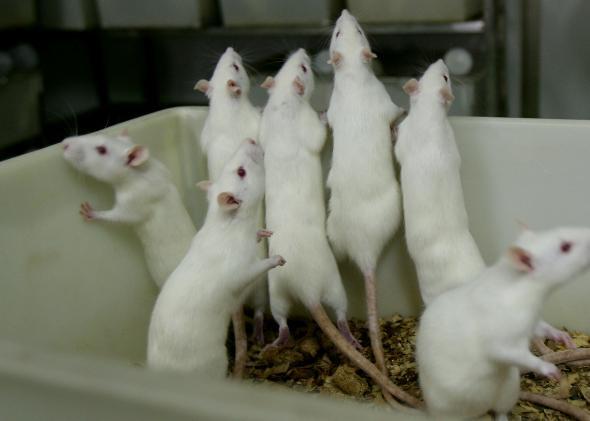In a piece published in Nature on Wednesday, two leaders from the National Institutes of Health, Dr. Francis Collins and Dr. Janine Clayton, admonished drug researchers to start including female test subjects in drug research. Right now, many animal trials of various drugs only include male rats, pigs, or dogs. “The over-reliance on male animals and cells in preclinical research obscures key sex differences that could guide clinical studies,” Collins and Clayton write. “And it might be harmful: women experience higher rates of adverse drug reactions than men do.”
The NIH has already asked researchers to fix this gender inequality when it comes to trials on humans, but the hope is that by including female and male subjects at earlier testing stages, the testing will be more comprehensive and rigorous from the start. “Certain rigorous studies evaluating the effects of sex differences have been effective in bridging the divide between animal and human work,” Collins and Clayton argue, pointing to how bi-gender animal research on multiple sclerosis demonstrated that biological differences between male and female bodies cause the disease to manifest differently in men and women.
That you shouldn’t exclude half a species in your testing seems obvious, but there are understandable, if not really defensible, reasons that scientists have typically stuck to male-only studies. Roni Caryn Rabin at the New York Times explains: “Researchers avoided using female animals for fear that their reproductive cycles and hormone fluctuations would confound the results of delicately calibrated experiments.” But while this tradition makes it easier to come up with clean results, the long-term effect is that drugs are being released that women are going to take without researchers always knowing exactly how those drugs will work on them. (After all, human females have reproductive cycles and hormone fluctuations, too.)
Feminists in science have long been advocating for an end to the habit of male-only studies for just this reason. That’s part of why the University of Wisconsin started a feminist biology program to help critique and improve biology by targeting some of the unquestioned gender bias that sadly continues to flourish in the field. Janet Hyde, director of the University of Wisconsin’s Center for Research on Gender & Women, singled out this particular issue when speaking to Kat Stoeffel of The Cut:
You can think of feminist biology as having two components. First, it identifies gender bias in traditional biology and alerting students and scientists to possible gender bias. Scientists want, in general, to be not biased, so in a way this is just improving biology, right? Another part is constructing new theories and new research that does away with these biases and leads to a more balanced biology that takes women into account. One of my favorite examples is we now know that taking baby aspirin prevents heart attacks and strokes. The original clinical trials, which were funded by the National Institute of Health, were done on a male-only sample. A feminist biologist would say there’s gender bias in that design; we can’t assume it’s going to work for women. We want to correct biases like that in biomedical research.
Of course, anything with the word feminist attached to it gets a knee-jerk reaction, and the formation of this program was no exception. Christina Hoff Sommers complained, “We don’t need feminist biology any more than we need femistry or galgebra.” She’s wrong: As the New York Times reports, women make up half of subjects in institute-funded studies, but “women still are often underrepresented in clinical trials carried out by drug companies and medical device manufacturers.” No surprise there. Putting female subjects in your experiment increases the variety in the results, no doubt slowing the march to get drugs onto the market and making money. Hopefully, increasing pressure from the NIH will fix that.
